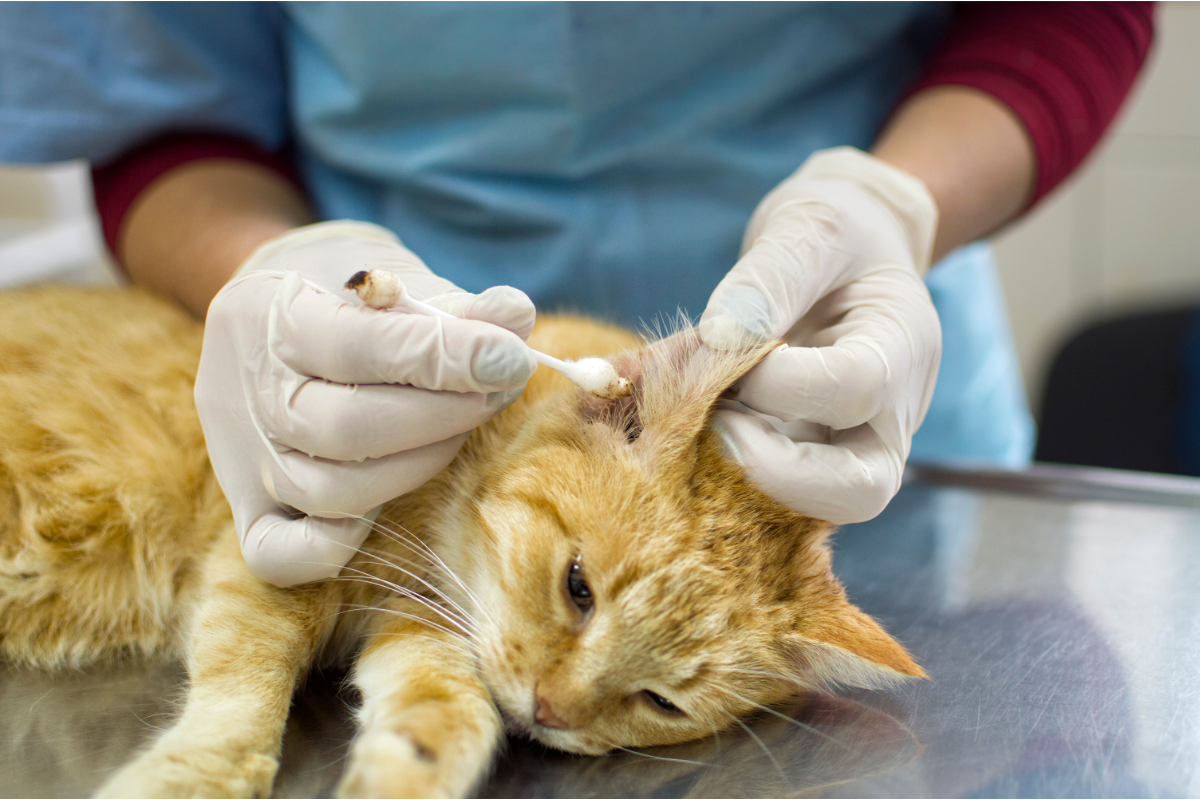Ear scab, also known as otacariosis, is a common parasitic disease of dogs, cats and ferrets. Otodectes cynotis, a mite, causes the disease by feeding on earwax and skin debris in the animal’s ear canal. This highly contagious disease can lead to serious complications if not treated quickly.
What causes this disease?
Ear mange, or otacariosis, is caused by a mite, Otodectes cynotis. The mite lives and feeds in the animal’s ear canal. This microscopic parasite feeds on earwax and skin debris. The mites multiply rapidly, laying eggs in the ear canal, where the larvae hatch and develop into adults within a few weeks.
This parasitic disease is highly contagious, easily transmitted by direct contact from an infested animal to a healthy one. Cats and dogs living in groups or communities are at particular risk, as are young animals that may be infected by their mothers. Transmission can also occur through simple encounters between animals, for example during walks or visits to the vet.
The Otodectes cynotis parasite, specific to dogs, cats and ferrets, lodges in the ear canal. It causes a local inflammatory reaction. This inflammation is due to the presence of mites that feed on earwax and skin debris. The females lay their eggs in the ear canal. The larvae that hatch continue the reproduction cycle. They thus increase the infestation.
It is important to note that this disease can also affect rabbits, although the parasite responsible is a different species, Psoroptes cuniculi. The symptoms and mode of transmission remain similar, making ear mange a disease of concern for owners of several species of animal.
What are the symptoms of ear mange?
The symptoms of ear mange vary slightly between dogs and cats, although certain common signs can be observed in both species.
In dogs
In dogs, ear mange manifests itself as intense itching. Dogs frequently scratch their ears, often to the point of injuring themselves. The inside of the ear may become red and inflamed, with excessive production of blackish, smelly earwax, rich in parasites. By scratching, the dog can rupture blood vessels, leading to the formation of an othematoma, an accumulation of blood between the skin and the cartilage of the ear, making it hang down and swell.
In cats
In cats, the symptoms may be more discreet, but the brownish interior of the ear is characteristic. Cats also scratch their ears, often shake their heads and may have reddish crusts mixed with earwax. Pruritic otitis caused by mites can damage the inner ear, leading to loss of balance and staggering.
Cats may also show signs of itching on other parts of their body, such as the head, neck, base of tail and back, as the parasites can spread outside the ears. Dry, blackish earwax, similar to coffee grounds, and an unusual odour emanating from the ears are clear indicators of ear mange.
How is it diagnosed?
Diagnosis of ear mange requires a visit to the vet, who will carry out a full examination of your pet’s ears. The vet generally uses an otoscope to inspect the ear canals for parasites, infections or foreign bodies. When signs of mange appear, the vet will take an earwax sample for microscopic analysis of the presence of Otodectes cynotis.
It is crucial to differentiate ear scabies from other types of ear infections, caused by mites such as sarcoptes, demodex or bacterial and fungal infections. The vet can also check for foreign bodies, which could be the primary cause of the ear infection.
If in doubt, the earwax sample will be analysed under a microscope to confirm the presence of parasites. This step ensures that the prescribed treatment will be effective against the Otodectes cynotis mite. It is important to treat quickly to avoid more serious complications, such as severe otitis externa, which could spread and damage the inner ear, causing balance problems.
What treatments are available?
Treatment for earwax begins with thorough cleaning of the ear canals with earwax-dissolving acaricide products, followed by the application of antiparasitic drops or ointments. Acaricide products kill the adult parasites, but to completely eradicate the infestation, the treatment must be continued for 8 to 10 weeks to cover the entire reproduction cycle of the mites.
It is crucial to treat all the animals in the house at the same time to avoid cross-contamination. The treatment prescribed by the vet may include ear drops, ointments or topical solutions. The vet will also show the owner how to clean the ears properly to maximise the effectiveness of the treatment.
It is essential to adhere to the treatment schedule, even if the symptoms disappear quickly. A seemingly cured animal may still be carrying parasites. It is also advisable to treat both ears, even if only one is affected, to prevent future infestation.
After applying the anti-mite cream, massage the base of the ear to ensure the product spreads evenly. Regular cleaning of the ears with a suitable product, even after recovery, helps prevent recurrences.
What are the natural alternatives?
For those who prefer natural treatments, there are several options for treating ear mange in animals. Essential oils and natural extracts offer effective anti-parasitic and soothing properties.
Calendula, Calophylla Inophyla and St John’s Wort oily macerates provide immediate soothing properties. Tea Tree and Laurel essential oils offer powerful anti-parasitic and anti-infectious effects, effectively eliminating dust mites. Aspic Lavender provides rapid relief for affected animals thanks to its anti-itching properties.
Clove essential oil is particularly effective against mange. It contains eugenol, a powerful aromatic phenol, which kills Sarcoptes larvae infiltrating the epidermis. However, it is essential to dilute this oil well before applying it, as it is dermocaustic.
Colloidal silver is a powerful antibacterial, antiviral and antifungal agent, useful for treating wounds and skin problems in dogs and cats.Lavender hydrosol is also used for its anti-parasite and anti-itching properties.
For internal antiviral action, use grapefruit seed extract, while propolis works effectively for oral application. Apply these natural treatments with care and, ideally, under the supervision of a vet to avoid any adverse reactions. Essential oils should not be used on cats.
What can be done to prevent the disease?
Preventing ear mange is essential to ensure the health and well-being of your pets. Although this disease is not transmissible to humans, it is extremely contagious between animals.
Regularly checking the condition of your dog’s or cat’s ears is the first step in prevention. Owners should be particularly vigilant after contact with other animals or after spending time in a group setting.
Regular use of external antiparasitics, effective against ticks and fleas, is also recommended. These products are often effective against the mites responsible for ear mange.
Maintaining good environmental hygiene is crucial. Regularly clean your pets’ sleeping accessories, such as baskets, cushions and blankets. Use specific products to treat the environment against parasites, available from your vet.
If an animal is diagnosed with ear mange, it is important to treat all the animals in the household at the same time to avoid re-infestation. Even if the symptoms are not immediately visible in all the animals, transmission is possible, and treating the whole “pack” ensures a complete cure and prevents the disease spreading.





